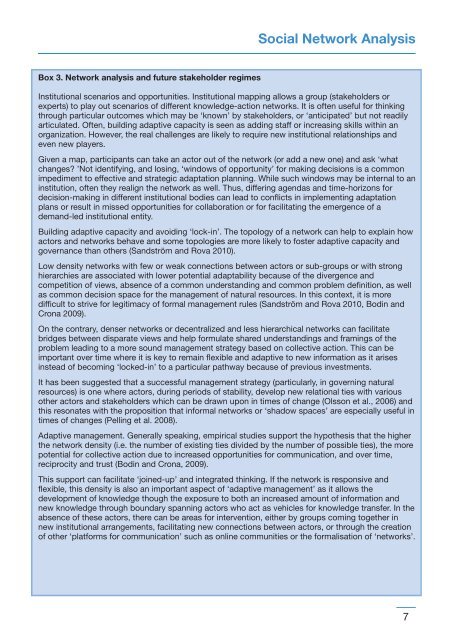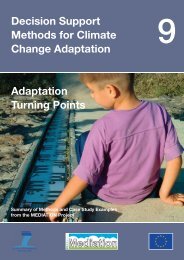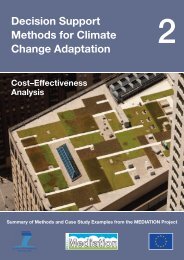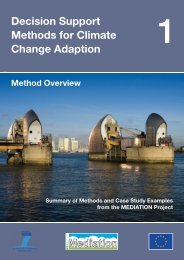Download all Technical Policy Briefing Notes in a single ... - Mediation
Download all Technical Policy Briefing Notes in a single ... - Mediation
Download all Technical Policy Briefing Notes in a single ... - Mediation
- No tags were found...
Create successful ePaper yourself
Turn your PDF publications into a flip-book with our unique Google optimized e-Paper software.
Social Network AnalysisBox 3. Network analysis and future stakeholder regimesInstitutional scenarios and opportunities. Institutional mapp<strong>in</strong>g <strong>all</strong>ows a group (stakeholders orexperts) to play out scenarios of different knowledge-action networks. It is often useful for th<strong>in</strong>k<strong>in</strong>gthrough particular outcomes which may be ‘known’ by stakeholders, or ‘anticipated’ but not readilyarticulated. Often, build<strong>in</strong>g adaptive capacity is seen as add<strong>in</strong>g staff or <strong>in</strong>creas<strong>in</strong>g skills with<strong>in</strong> anorganization. However, the real ch<strong>all</strong>enges are likely to require new <strong>in</strong>stitutional relationships andeven new players.Given a map, participants can take an actor out of the network (or add a new one) and ask ‘whatchanges? ’Not identify<strong>in</strong>g, and los<strong>in</strong>g, ‘w<strong>in</strong>dows of opportunity’ for mak<strong>in</strong>g decisions is a commonimpediment to effective and strategic adaptation plann<strong>in</strong>g. While such w<strong>in</strong>dows may be <strong>in</strong>ternal to an<strong>in</strong>stitution, often they realign the network as well. Thus, differ<strong>in</strong>g agendas and time-horizons fordecision-mak<strong>in</strong>g <strong>in</strong> different <strong>in</strong>stitutional bodies can lead to conflicts <strong>in</strong> implement<strong>in</strong>g adaptationplans or result <strong>in</strong> missed opportunities for collaboration or for facilitat<strong>in</strong>g the emergence of ademand-led <strong>in</strong>stitutional entity.Build<strong>in</strong>g adaptive capacity and avoid<strong>in</strong>g ‘lock-<strong>in</strong>’. The topology of a network can help to expla<strong>in</strong> howactors and networks behave and some topologies are more likely to foster adaptive capacity andgovernance than others (Sandström and Rova 2010).Low density networks with few or weak connections between actors or sub-groups or with stronghierarchies are associated with lower potential adaptability because of the divergence andcompetition of views, absence of a common understand<strong>in</strong>g and common problem def<strong>in</strong>ition, as wellas common decision space for the management of natural resources. In this context, it is moredifficult to strive for legitimacy of formal management rules (Sandström and Rova 2010, Bod<strong>in</strong> andCrona 2009).On the contrary, denser networks or decentralized and less hierarchical networks can facilitatebridges between disparate views and help formulate shared understand<strong>in</strong>gs and fram<strong>in</strong>gs of theproblem lead<strong>in</strong>g to a more sound management strategy based on collective action. This can beimportant over time where it is key to rema<strong>in</strong> flexible and adaptive to new <strong>in</strong>formation as it arises<strong>in</strong>stead of becom<strong>in</strong>g ‘locked-<strong>in</strong>’ to a particular pathway because of previous <strong>in</strong>vestments.It has been suggested that a successful management strategy (particularly, <strong>in</strong> govern<strong>in</strong>g naturalresources) is one where actors, dur<strong>in</strong>g periods of stability, develop new relational ties with variousother actors and stakeholders which can be drawn upon <strong>in</strong> times of change (Olsson et al., 2006) andthis resonates with the proposition that <strong>in</strong>formal networks or ‘shadow spaces’ are especi<strong>all</strong>y useful <strong>in</strong>times of changes (Pell<strong>in</strong>g et al. 2008).Adaptive management. Gener<strong>all</strong>y speak<strong>in</strong>g, empirical studies support the hypothesis that the higherthe network density (i.e. the number of exist<strong>in</strong>g ties divided by the number of possible ties), the morepotential for collective action due to <strong>in</strong>creased opportunities for communication, and over time,reciprocity and trust (Bod<strong>in</strong> and Crona, 2009).This support can facilitate ‘jo<strong>in</strong>ed-up’ and <strong>in</strong>tegrated th<strong>in</strong>k<strong>in</strong>g. If the network is responsive andflexible, this density is also an important aspect of ‘adaptive management’ as it <strong>all</strong>ows thedevelopment of knowledge though the exposure to both an <strong>in</strong>creased amount of <strong>in</strong>formation andnew knowledge through boundary spann<strong>in</strong>g actors who act as vehicles for knowledge transfer. In theabsence of these actors, there can be areas for <strong>in</strong>tervention, either by groups com<strong>in</strong>g together <strong>in</strong>new <strong>in</strong>stitutional arrangements, facilitat<strong>in</strong>g new connections between actors, or through the creationof other ‘platforms for communication’ such as onl<strong>in</strong>e communities or the formalisation of ‘networks’.7





